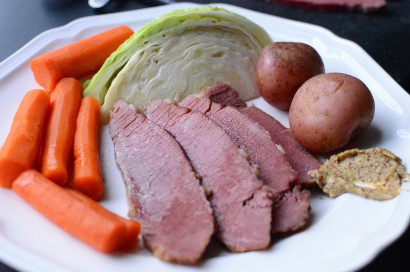No Reviews
You must be logged in to post a review.

I recently learned how easy it is to make corned beef from scratch, and I thought since St. Patrick’s Day is just around the corner, I’d share how it’s done. And let me just go on the record and say this: you may never go back to the stuff from the grocery store again.
Be sure to plan ahead—the brisket needs to brine for 6–8 days before cooking.
To brine the brisket (6-8 days before cooking):
In a 12-quart or larger non-reactive container (glass, ceramic, plastic, or stainless steel), add water. Whisk in table salt, brown sugar, and curing salt until dissolved. Add bay leaves, whole garlic cloves, black peppercorns, coriander seeds, and allspice berries.
Place trimmed beef brisket into brine, cover, and refrigerate for a minimum of 6 days and a maximum of 8 days (brisket should stay completely submerged—use a dinner plate to weigh it down if necessary).
To cook the corned beef:
Remove brisket from brine and discard brine. Preheat oven to 250ºF. In an 8-quart or larger stockpot over medium-high heat, combine cold water, bay leaves, whole garlic cloves, black peppercorns, and the brined brisket until it reaches the boiling point. Turn off heat, cover, and place in preheated oven for 3 hours.
Remove stockpot from oven and return to stovetop. Transfer corned beef to a platter and drizzle some of the cooking liquid over to keep it from drying out. Add cabbage, carrots, and potatoes to the stockpot and bring to a simmer for 15–30 minutes or until the potatoes are tender (remove the cabbage after 10 minutes). Slice beef across the grain and serve with the cooked vegetables.
Note: Pink curing should not be confused with pickling salt, pink himalayan salt, or pink Peruvian salt (look for Instacure #1 or Prague powder #1). It should contain a mixture of sodium chloride and sodium nitrite. The difference between curing salt #1 and #2? Basically, curing salt #1 is used to preserve things that will be cooked, such as corned beef, sausage, bacon, etc. Curing salt #2 is used to preserve things that will be air dried, such as salami, pepperoni, jerky, etc.
Recipe adapted from America’s Test Kitchen.
No Comments
Leave a Comment!
You must be logged in to post a comment.